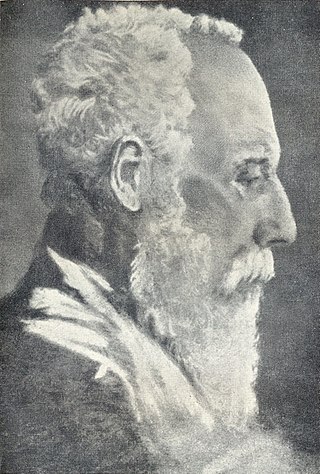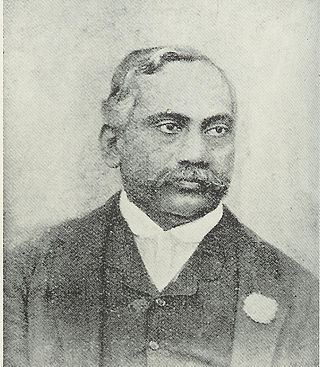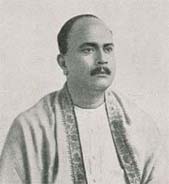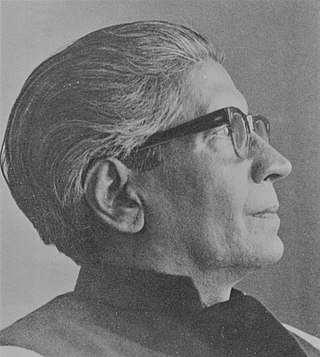Related Research Articles

Raja Ram Mohan Roy was an Indian reformer who was one of the founders of the Brahmo Sabha in 1828, the precursor of the Brahmo Samaj, a social-religious reform movement in the Indian subcontinent. He was given the title of Raja by Akbar II, the Mughal emperor. His influence was apparent in the fields of politics, public administration, education and religion. He was known for his efforts to abolish the practices of sati and child marriage. Roy is considered to be the "Father of Indian Renaissance" by many historians.
Contemporary groups, collectively termed Hindu reform movements, reform Hinduism, Neo-Hinduism, or Hindu revivalism, strive to introduce regeneration and reform to Hinduism, both in a religious or spiritual and in a societal sense. The movements started appearing during the Bengali Renaissance.

Debendranath Tagore was an Indian philosopher and religious reformer, active in the Brahmo Samaj. He joined Brahmo samaj in 1842. He was the founder in 1848 of the Brahmo religion, which today is synonymous with Brahmoism. Born in Shilaidaha, his father was the industrialist Dwarakanath Tagore; he himself had 14 children, many of whom, including Nobel-prize winning poet Rabindranath Tagore, made significant artistic or literary contributions to society.
Brahmo Samaj is the societal component of Brahmoism, which began as a monotheistic reformist movement that appeared during the Bengal Renaissance.

The Bengal Renaissance, also known as the Bengali Renaissance, was a cultural, social, intellectual, and artistic movement that took place in the Bengal region of the British Raj, from the late 18th century to the early 20th century. Historians have traced the beginnings of the movement to the victory of the British East India Company at the 1757 Battle of Plassey, as well as the works of reformer Raja Rammohan Roy, considered the "Father of the Bengal Renaissance," born in 1772. Nitish Sengupta stated that the movement "can be said to have … ended with Rabindranath Tagore," Asia's first Nobel laureate.

David Hare (1775–1842) was a Scottish watchmaker and philanthropist in Bengal, India. He founded many educational institutions in Calcutta, such as the Hindu School, and Hare School and helped in founding Presidency College.

Henry Louis Vivian Derozio was an Indian poet and assistant headmaster of Hindu College, Kolkata. He was a radical thinker of his time and one of the first Indian educators to disseminate Western learning and science among the young men of Bengal.

Hindu School is a state government-administered school in Kolkata (Calcutta), India. Founded in 1817, it is the oldest modern educational institution in Asia.

Rajnarayan Basu (1826–1899) was an Indian writer and intellectual of the Bengal Renaissance. He was born in Boral in 24 Parganas and studied at the Hare School and Hindu College, in Kolkata, Bengal. A monotheist at heart, Rajnarayan Basu converted to the Brahmoism sect at the age of twenty. After retiring, he was given the honorary title of Rishi or sage. As a writer, he was one of the best known prose writers in Bengali in the nineteenth century, writing often for the Tattwabodhini Patrika, a premier Brahmo journal. Due to his defence of Brahmoism, he was given the title "Grandfather of Indian Nationalism".

Manmohun Ghose was the first practicing barrister of Indian origin. He is notable for his contributions towards the fields of women's education, for arousing the patriotic feeling of his countrymen and for being one of the earliest persons in the country in organised national politics. At the same time his Anglicised habits often made him a target of ridicule in Calcutta.
Brahmoism is a Hindu religious movement which originated from the mid-19th century Bengali Renaissance, the nascent Indian independence movement. Adherents, known as Brahmos, are mainly of Indian or Bangladeshi origin or nationality.
The modern religious philosophy of Brahmoism is based in part on the foundations of reformer Raja Ram Mohan Roy's humanitarian philosophy, as exemplified by the Trust Deed of Brahmo Sabha, known to Brahmos as the 1830 Brahmo Trust Deed.
The Tattwabodhinī Sabhā was a group founded in Calcutta on 6 October 1839 as a splinter group of the Brahmo Samaj, reformers of Hinduism and Indian Society. The founding member was Debendranath Tagore, previously of the Brahmo Samaj, eldest son of influential entrepreneur Dwarkanath Tagore, and eventually father to renowned polymath Rabindranath Tagore. In 1859, the Tattwabodhinī Sabhā were dissolved back into the Brāhmo Samāj by Debendranath Tagore.

Raman Siva Kumar, known as R. Siva Kumar, is an Indian contemporary art historian, art critic, and curator. His major research has been in the area of early Indian modernism with special focus on the Santiniketan School. He has written several important books, lectured widely on modern Indian art and contributed articles to prestigious international projects such as the Art Journal, Grove Art Online or The Dictionary of Art, Oxford University Press.

Atul Prasad Sen was a Bengali composer, lyricist and singer, and also a lawyer, philanthropist, social worker, educationist and writer.
Maghotsav is the main festival of the Brahmos celebrated on 11 Magh each year according to the Bengali calendar to mark the anniversary of Brahmo Samaj. The celebration commemorates the inauguration of the first Brahmo Samaj by Ram Mohan Roy on 23 January 1830, which was on 11 Magh according to the Bengali calendar in that year.

Sunayani Devi was an Indian painter born into the aristocratic Tagore family in Calcutta, West Bengal. She was a self taught artist, with no academic training in art. Inspired by her brothers, Abanindranath Tagore, Gaganendranath Tagore, and Samarendranath Tagore, she started painting only at the age of 30. She was married at the age of 12 to the grandson of Raja Ram Mohan Roy.

Rao Sahib Ayyathan Gopalan, popularly known as Darsarji and Darsar Sahib, was an Indian doctor, surgeon, professor, writer, philanthropist, social reformer, and Renaissance leader from Kerala. He is the founder of the Sugunavardhini movement (1900) and Depressed classes mission (1909) and also the leader and propagandist of Brahmo Samaj (1893) in Kerala. He denounced idol worship and fought to end those social practices in Kerala that he thought were unethical. Among his followers were Brahmananda Swami Sivayogi, Vaghbatananda, and Brahmavadhi P. Kunhiraman. Gopalan titled P. Kunhiraman as "Brahmavadhi" and Sivayogi as "Brahmananda Swami".

Abu Sayeed Ayyub was an Indian philosopher, teacher, literary critic and writer in both Bengali and English. Though born into a traditional, Urdu-speaking, Muslim family in Calcutta (Kolkata), he was so deeply captivated in his early teenage by the poems of the Indian Nobel Laureate Rabindranath Tagore that he taught himself Bengali so as to appreciate Tagore better. Later, when he started to write, it was mostly in his adopted language, Bengali. During the initial part of his writing career, Ayyub wrote on aesthetics, religion and socialism. However, it was his philosophical and scientific analysis of creative literature - in particular the poetry and the drama of Tagore - that finally brought him wide recognition as "one of the most serious and original Tagore scholars". Ayyub is also credited with "co-editing the first anthology of modern Bengali poetry". He taught philosophy at the University of Calcutta, the Visva-Bharati University and the University of Melbourne, and edited the literary and philosophical journal Quest.
Anarchism in Bangladesh has its roots in the ideas of the Bengali Renaissance and began to take influence as part of the revolutionary movement for Indian independence in Bengal. After a series of defeats of the revolutionary movement and the rise of state socialist ideas within the Bengali left-wing, anarchism went into a period of remission. This lasted until the 1990s, when anarchism again began to reemerge after the fracturing of the Communist Party of Bangladesh, which led to the rise of anarcho-syndicalism among the Bangladeshi workers' movement.
References
- ↑ Elites in south asia. CUP Archive. pp. 66–. GGKEY:R8YQ4FKC94Z.
- 1 2 Harold Coward (30 October 1987). Modern Indian Responses to Religious Pluralism. SUNY Press. pp. 20–. ISBN 978-0-88706-572-9.
- ↑ Kshīrasāgara, Rāmacandra (1 January 1994). Dalit Movement in India and Its Leaders, 1857-1956. M.D. Publications Pvt. Ltd. pp. 51–. ISBN 978-81-85880-43-3.
- 1 2 R.K. Pruthi (1 January 2004). Brahmo Samaj and Indian Civilization. Discovery Publishing House. pp. 191–. ISBN 978-81-7141-791-9.